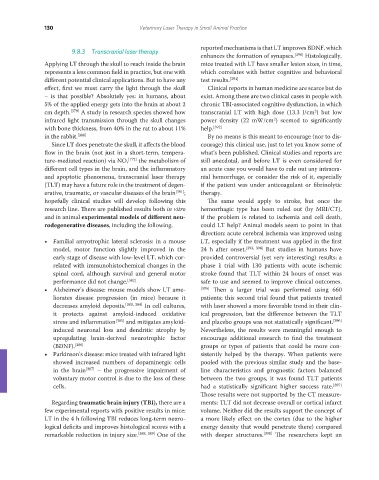Page 144 - Veterinary Laser Therapy in Small Animal Practice
P. 144
130 Veterinary Laser Therapy in Small Animal Practice
9.8.3 Transcranial laser therapy reported mechanisms is that LT improves BDNF, which
enhances the formation of synapses. [390] Histologically,
Applying LT through the skull to reach inside the brain mice treated with LT have smaller lesion sizes, in time,
represents a less common field in practice, but one with which correlates with better cognitive and behavioral
different potential clinical applications. But to have any test results. [391]
effect, first we must carry the light through the skull Clinical reports in human medicine are scarce but do
– is that possible? Absolutely yes: in humans, about exist. Among these are two clinical cases in people with
5% of the applied energy gets into the brain at about 2 chronic TBI-associated cognitive dysfunction, in which
2
cm depth. [379] A study in research species showed how transcranial LT with high dose (13.3 J/cm ) but low
infrared light transmission through the skull changes power density (22 mW/cm ) seemed to significantly
2
with bone thickness, from 40% in the rat to about 11% help. [392]
in the rabbit. [380] By no means is this meant to encourage (nor to dis-
Since LT does penetrate the skull, it affects the blood courage) this clinical use, just to let you know some of
flow in the brain (not just in a short-term, tempera- what’s been published. Clinical studies and reports are
ture-mediated reaction) via NO, [172] the metabolism of still anecdotal, and before LT is even considered for
different cell types in the brain, and the inflammatory an acute case you would have to rule out any intracra-
and apoptotic phenomena, transcranial laser therapy nial hemorrhage, or consider the risk of it, especially
(TLT) may have a future role in the treatment of degen- if the patient was under anticoagulant or fibrinolytic
erative, traumatic, or vascular diseases of the brain [381] ; therapy.
hopefully clinical studies will develop following this The same would apply to stroke, but once the
research line. There are published results both in vitro hemorrhagic type has been ruled out (by MRI/CT),
and in animal experimental models of different neu- if the problem is related to ischemia and cell death,
rodegenerative diseases, including the following. could LT help? Animal models seem to point in that
direction: acute cerebral ischemia was improved using
• Familial amyotrophic lateral sclerosis: in a mouse LT, especially if the treatment was applied in the first
model, motor function slightly improved in the 24 h after onset. [393, 394] But studies in humans have
early stage of disease with low-level LT, which cor- provided controversial (yet very interesting) results: a
related with immunohistochemical changes in the phase 1 trial with 130 patients with acute ischemic
spinal cord, although survival and general motor stroke found that TLT within 24 hours of onset was
performance did not change. [382] safe to use and seemed to improve clinical outcomes.
• Alzheimer’s disease: mouse models show LT ame- [395] Then a larger trial was performed using 660
liorates disease progression (in mice) because it patients; this second trial found that patients treated
decreases amyloid deposits. [383, 384] In cell cultures, with laser showed a more favorable trend in their clin-
it protects against amyloid-induced oxidative ical progression, but the difference between the TLT
stress and inflammation [385] and mitigates amyloid- and placebo groups was not statistically significant. [396]
induced neuronal loss and dendritic atrophy by Nevertheless, the results were meaningful enough to
upregulating brain-derived neurotrophic factor encourage additional research to find the treatment
(BDNF). [386] groups or types of patients that could be more con-
• Parkinson’s disease: mice treated with infrared light sistently helped by the therapy. When patients were
showed increased numbers of dopaminergic cells pooled with the previous similar study and the base-
in the brain [387] – the progressive impairment of line characteristics and prognostic factors balanced
voluntary motor control is due to the loss of these between the two groups, it was found TLT patients
cells. had a statistically significant higher success rate. [397]
Those results were not supported by the CT measure-
Regarding traumatic brain injury (TBI), there are a ments: TLT did not decrease overall or cortical infarct
few experimental reports with positive results in mice: volume. Neither did the results support the concept of
LT in the 4 h following TBI reduces long-term neuro- a more likely effect on the cortex (due to the higher
logical deficits and improves histological scores with a energy density that would penetrate there) compared
remarkable reduction in injury size. [388, 389] One of the with deeper structures. [398] The researchers kept an
REDONDO PRINT (4-COL BLEED).indd 130 08/08/2019 09:48

